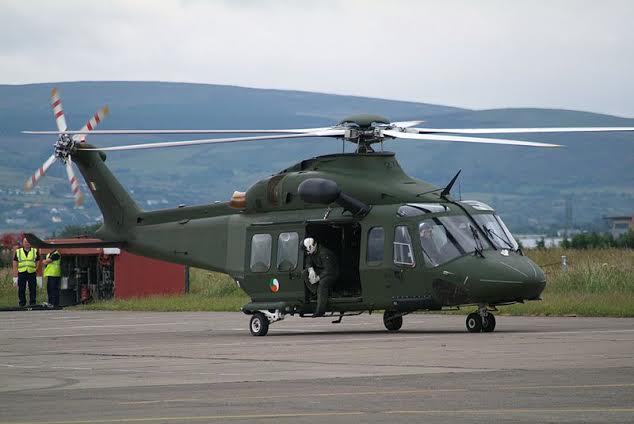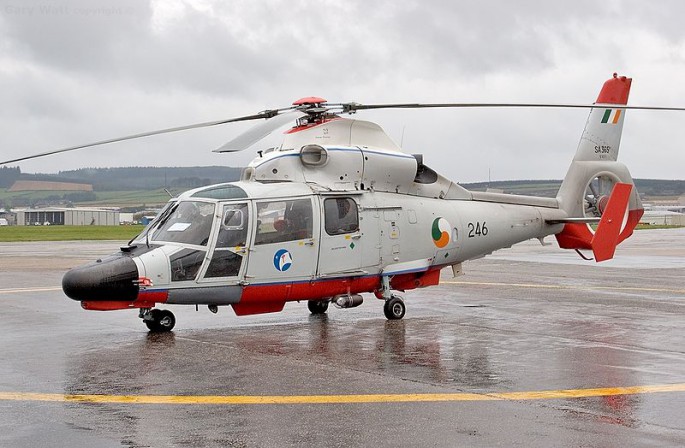50 years ago, the distinctive high-pitched sound of two Alouette III helicopters reverberated across the skies of Dublin for the very first time. The date was Nov. 26, 1963 and intrepid Irish Air Corps pilots were flying the then state of the art machines directly from France to Baldonnel on the outskirts of Ireland’s capital.
The arrival of callsigns A195 and A196 marked the beginning of rotary aviation in Ireland. When a French fishing trawler got into difficulty off Ireland’s west coast three weeks later, the new helicopters were called into action for the first time. Now known as No 3 Operations Wing, the unit has gone on to carry out more than 2,300 search and rescue missions and 4,000 air ambulance missions.
Eventually, a total of eight Alouette IIIs were acquired and utilized for troop transport, border patrol and air ambulance tasks alongside search and rescue. In 1986, these were bolstered by the purchase of five Dauphine IIs, two of which were modified for operations from the LÉ Eithne, a Naval Service patrol vessel.
The arrival of the Dauphin II was a technological leap for the Air Corps – equipped with twin engines and radar, it was better suited to operations over the harsh Atlantic than the single engined Alouette III. Nevertheless, the Alouette III soldiered on until 2007, carrying out 1,717 search and rescue missions, saving 542 lives.
Even though the Dauphin II performed extremely well, the helicopter was also central to one of the darkest days in Air Corps history. In July 1999, Dauphin DH248 impacted sand dunes near Waterford airport on the way back from a rescue mission, killing all four crew members. The last Gazelle and Dauphin helicopters were withdrawn from service at the end of 2005.
Two new EC135 light utility helicopters were delivered to Baldonnel in 2005, followed by six AgustaWestland AW139s between 2006 and 2008. This marked the start of a new era for Air Corps helicopter operations as the search and rescue mission was phased out and offered for public tender. Looking at the statistics, marine rescue is a high stakes enterprise and helicopters are the best solution. Today, coverage is the responsibility of the Irish Coast Guard operating five contracted Sikorsky S92s, powerful modern helicopters capable of providing effective coverage far out over the Atlantic.
Even though the search and rescue mission has been more or less discontinued, the AW139s and EC135s still cooperate closely with the army, transporting troops, equipment and dignitaries as well as supporting the country’s elite Army Ranger Wing. The new fleet of helicopters proved their worth time and time again in extreme weather, battling gorse fires in Donegal or supplying livestock trapped by heavy snow drifts in Northern Ireland. They can also be fitted out for search and rescue missions if necessary. Most recently, the AW139s have been tasked to airlift material to Skellig Michael, an essential step in renovating the Unesco world heritage site.
The air ambulance tasking is still vitally important for the Air Corps and a new service was launched in Athlone. Over the past 18 months, the helicopter based there has responded to over 800 callouts. The AW139 has provided the Air Corps with another impressive leap in technology and capability. Crews are now operating with night vision goggles on national and international air ambulance transfers and an incubator can be installed for newborns. The aircraft is also equipped with a Forward Looking Infra-red (FLIR) sensor and an advanced glass cockpit.
No 3 Operations Wing has become the most decorated unit in the Irish Defence Forces. Over the course of the past 50 years, 22 Distinguished Service Medals have been awarded, along with 12 Department of Marine Meritorious Medals and two French Federation Aeronautique Internationales “Diplome D’Honneur” for humanitarian service.
Young and old members of the Air Corps gathered at Baldonnel on November 21st for the unveiling of a ceremonial plaque commemorating the accomplishments of Ireland’s brave helicopter pilots. Some of the original crews that flew the first Alouette IIIs to Ireland in 1963 were present. The elite Ranger Wing also marked the anniversary by conducting a display of fastroping over the Curragh Camp in darkness.
Imagenote: Gary Watt & Gerry Gunner
Seamus Murphy writes for Trenditionist


















